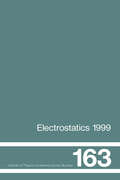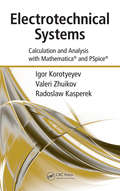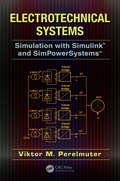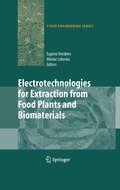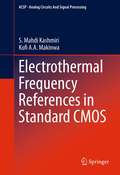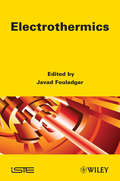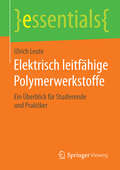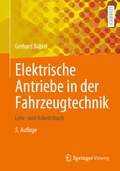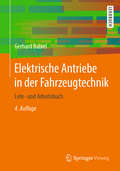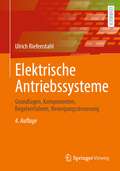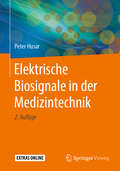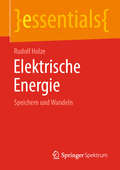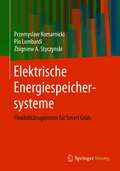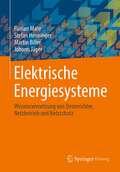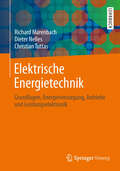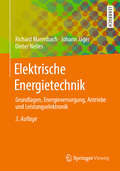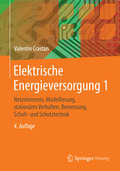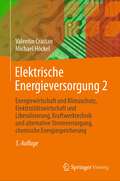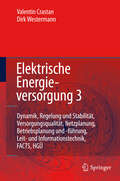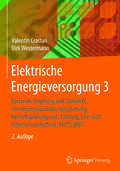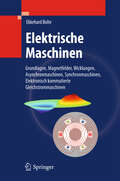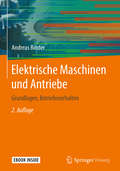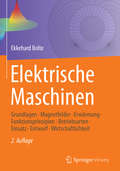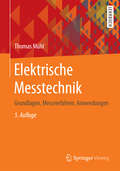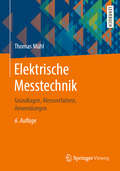- Table View
- List View
Electrostatics 1999, Proceedings of the 10th INT Conference, Cambridge, UK, 28-31 March 1999
by D.M. TaylorElectrostatics 1999: Proceedings of the 10th INT Conference, Cambridge, UK, 28-31 March 1999 provides an overview of recent research in electrostatics and an insight into the multifarious applications for electrostatics in industry. This comprehensive reference is ideal for researchers in physics, chemistry, and engineering who work in electrostati
Electrotechnical Systems: Calculation and Analysis with Mathematica and PSpice
by Igor Korotyeyev Valerii Zhuikov Radoslaw KasperekAdvances in mathematical methods, computer technology, and electrotechnical devices in particular continue to result in the creation of programs that are leading to increased labor productivity. Mathematical and simulation programs—and other programs that unite these two operations—provide the ability to calculate transitional, steady-state processes, stability conditions, and harmonic composition, and are often used to analyze processes in power electronic systems. Electrotechnical Systems: Calculation and Analysis with Mathematica and PSpice explores the potential of two such programs—Mathematica and ORCAD (PSpice)—as they are used for analysis in various areas. The authors discuss the formulation of problems and the steps in their solution. They focus on the analysis of transient, steady-state processes and their stability in non-stationary and nonlinear systems with DC and AC converters. All problems are solved using Mathematica, and program codes are presented. The authors use ORCAD (PSpice) to compare the results obtained by employing Mathematica and to demonstrate the peculiarities associated with its use.This book clearly and concisely illustrates represented expressions, variables, and functions and the general application of the mathematical pocket Mathematica 4.2 for the analysis of the electromagnetic processes in electrotechnical systems. It will be a valuable addition to the library of anyone working with electrotechnical systems.
Electrotechnical Systems: Simulation with Simulink® and SimPowerSystems™
by Viktor PerelmuterFilling a gap in the literature, Electrotechnical Systems: Simulation with Simulink® and SimPowerSystems™ explains how to simulate complicated electrical systems more easily using SimPowerSystems™ blocks. It gives a comprehensive overview of the powerful SimPowerSystems toolbox and demonstrates how it can be used to create and investigate models of both classic and modern electrotechnical systems.Build from Circuit Elements and Blocks to System ModelsBuilding from simple to more complex topics, the book helps readers better understand the principles, features, and detailed functions of various electrical systems, such as electrical drives, power electronics, and systems for production and distribution of electrical energy. The text begins by describing the models of the main circuit elements, which are used to create the full system model, and the measuring and control blocks. It then examines models of semiconductor devices used in power electronics as well as models of DC and AC motors. The final chapter discusses the simulation of power production and transmission systems, including hydraulic turbine, steam turbine, wind, and diesel generators. The author also develops models of systems that improve the quality of electrical energy, such as active filters and various types of static compensators. Get a Deeper Understanding of Electrical Systems and How to Simulate ThemThe downloadable resources supply nearly 100 models of electrotechnical systems created using SimPowerSystems. These encompass adaptations of SimPowerSystems demonstrational models, as well as models developed by the author, including many important applications related to power electronics and electrical drives, which are not covered by the demonstrational models. In addition to showing how the models can be used, he supplies the theoretical background for each.
Electrotechnologies for Extraction from Food Plants and Biomaterials
by Eugene Vorobiev Nikolai LebovkaRecently, the electrotechnologies based on the effects of pulsed electric fields (PEF), such as ohmic heating (OH) and DC electric field, have gained real interest in the field of food processing. These techniques efficiently enhance methods of extraction from food plants and dehydration of biosolids. The PEF and pulsed OH techniques preserve the nutritional, functional, structural and sensory properties of products better than conventional extraction technologies. The electrofiltration and electro-osmotic dewatering can be very effective for the separation of bioproducts and dehydration of food wastes. The first source book in the field, this book gives an overview the fundamental principles of electrical techniques, electrophysical properties of foods and agricultural products, application of various emerging electrotechnologies for enhancing the solid-liquid separation and drying processes, extraction techniques of pigments, processing methods of different in-plant tissues and biosolids, electro-osmotic dewatering and electrofiltration of biomaterials, recent industrial- scale gains, and other aspects. Each chapter is complementary to other chapters and addresses the latest efforts in the field.
Electrothermal Frequency References in Standard CMOS
by Kofi A. Makinwa S. Mahdi KashmiriThis book describes an alternative method of realizing accurate on-chip frequency references in standard CMOS processes. This method exploits the thermal-diffusivity of silicon, i.e. the rate at which heat diffuses through a silicon substrate. This is the first book describing the design of such electrothermal frequency references. It includes the necessary theory, supported by practical realizations that achieve inaccuracies as low as 0.1% and thus demonstrate the feasibility of this approach. The book also includes several circuit and system-level solutions to the precision circuit design challenges encountered during the design of such frequency references.
Electrothermics
by Javad FouladgarThis book concerns the analysis and design of induction heating of poor electrical conduction materials. Some innovating applications such as inductive plasma installation or transformers, thermo inductive non-destructive testing and carbon-reinforced composite materials heating are studied. Analytical, semi-analytical and numerical models are combined to obtain the best modeling technique for each case. Each model has been tested with experimental results and validated. The principal aspects of a computational package to solve these kinds of coupled problems are described. In the first chapter, the mathematical tools for coupled electromagnetic and thermal phenomena are introduced. In Chapter 2, these tools are used to analyze a radio frequency inductive plasma installation. The third chapter describes the methodology of designing a low frequency plasma transformer. Chapter 4 studies the feasibility of the thermo inductive technique for non-destructive testing and the final chapter is dedicated to the use of induction heating in the lifecycle of carbon-reinforced composite materials. Contents 1. Thermal and Electromagnetic Coupling, Javad Fouladgar, Didier Trichet and Brahim Ramdane.2. Simplified Model of a Radiofrequency Inductive Thermal Plasma Installation, Javad Fouladgar and Jean-Pierre Ploteau.3. Design Methodology of A Very Low-Frequency Plasma Transformer, Javad Fouladgar and Souri Mohamed Mimoune.4. Non Destructive Testing by Thermo-Inductive Method, Javad Fouladgar, Brahim Ramdane, Didier Trichet and Tayeb Saidi.5. Induction Heating of Composite Materials, Javad Fouladgar, Didier Trichet, Samir Bensaid and Guillaume Wasselynck
Elektrisch leitfähige Polymerwerkstoffe: Ein Überblick für Studierende und Praktiker (essentials)
by Ulrich LeuteUlrich Leute beschreibt sowohl polymere Materialien, die elektrische Leitfähigkeit ermöglichen, als auch deren wichtigsten Anwendungsfelder. Die genannten Technik- und Wissenschaftsfelder sind inhaltlich sehr weit voneinander entfernt verortet. Daher beschränkt sich diese Darstellung nicht nur auf ein einziges Arbeitsgebiet, sondern ist fachübergreifend angelegt
Elektrische Antriebe in der Fahrzeugtechnik: Lehr- und Arbeitsbuch
by Gerhard BabielDas Lehrbuch vermittelt die Grundlagen von der Energiegewinnung über die Energiewandlung bis zur Drehfeldmaschine und deren Anwendung in heutigen und vor allem zukünftigen Antriebssystemen. Zunächst werden aktuelle und zukünftige Energiequellen für Fahrzeugantriebe vorgestellt und miteinander verglichen. Darauf aufbauend werden elektrochemische Energiespeicher und -wandler wie die Wasserstoff-Brennstoffzelle behandelt. Es werden Gleichstrom-, Asynchron-, Synchron- und Linearmotor sowie Reluktanz-, Transversalfluss- und Digital-Motoren erklärt. Im letzten Kapitel werden Antriebssysteme am Beispiel einer E-Lok und der Magnetschwebebahn bzw. dem supraleitenden MAGLEV vorgestellt. Ein eigenes Kapitel ist dem KineticEnergyRestoring System KERS gewidmet, welches in der Formel 1 bereits erfolgreich zum Einsatz kommt. Mit E-Maschinen in Flugsystemen blicken wir ein Stück weit in die Zukunft.
Elektrische Antriebe in der Fahrzeugtechnik: Lehr- und Arbeitsbuch (Studium Technik Ser.)
by Gerhard BabielDas Lehrbuch vermittelt die Grundlagen von der Energiegewinnung über die Energiewandlung bis zur Drehfeldmaschine und deren Anwendung in heutigen und vor allem zukünftigen Antriebssystemen. Zunächst werden aktuelle und zukünftige Energiequellen für Fahrzeugantriebe vorgestellt und miteinander verglichen. Darauf aufbauend werden elektrochemische Energiespeicher und -wandler wie die Brennstoffzelle behandelt. Diese kommen u. a. in E- oder Hybridfahrzeugen zum Einsatz. Es werden nicht nur die Standardmaschinen wie Gleichstrom-, Asynchron-, Synchron- und Linearmotor erklärt, sondern auch solche, die in zukünftigen Pkw- und Bahnantrieben zum Einsatz kommen werden, wie z. B. Reluktanz-, Transversalfluss- und Digital-Motoren. Im letzten Kapitel werden Antriebssysteme am Beispiel einer E-Lok und der Magnetschwebebahn bzw. dem supraleitenden MAGLEV vorgestellt. Ein eigenes Kapitel ist dem Kinetic Energy Restoring System KERS gewidmet, welches in der Formel 1 bereits erfolgreich zum Einsatz kommt. Schrittmotoren ergänzen das Kapitel E-Maschinen.
Elektrische Antriebssysteme: Grundlagen, Komponenten, Regelverfahren, Bewegungssteuerung
by Ulrich RiefenstahlDer hohe Entwicklungsstand bei den elektrischen Maschinen sowie die großen Fortschritte in der Leistungselektronik, Mikroprozessortechnik und Kommunikationstechnik im letzten Jahrzehnt erlauben die Realisierung qualitativ hochwertiger elektrischer Antriebssysteme, die bei minimalem gerätetechnischen Aufwand eine verlustarme Energiewandlung, dynamisch hochwertige Bewegungsvorgänge und eine schnelle Inbetriebnahme ermöglichen. Das Buch stellt das Gesamtgebiet der elektrischen Antriebssysteme ausgehend von den Komponenten über die Steuer- und Regelverfahren bis hin zu ausgewählten Anwendungsbeispielen übersichtlich dar. In der dritten Auflage wurden einige Kapitel und Beispiele überarbeitet und an neue Entwicklungen im Fachgebiet angepasst.
Elektrische Biosignale in der Medizintechnik
by Peter HusarDas grundlegende Kompendium führt in das zunehmend wichtiger werdende Thema der Biosginalverarbeitung ein. Der inhaltliche Aufbau orientiert sich an der Abfolge der diagnostischen Kette: von Sensorik, Signalverstärkung und -konditionierung über Signalabtastung und -digitalisierung, Methoden der Biosignalverarbeitung bis zu Auswertung und Diagnosevorschlag. Dabei liefert jedes Kapitel das entsprechende theoretische und methodische Wissen, behandelt Realisierungsalternativen und stellt Praxisbeispiele sowie die aktuell verfügbare Technik vor.
Elektrische Energie: Speichern und Wandeln (essentials)
by Rudolf HolzeRudolf Holze stellt in diesem essential Möglichkeiten, Systeme und Verfahren der Wandlung elektrischer Energie in andere Energieformen wie auch aus diesen zurück in elektrische Energie mit einem Schwerpunkt auf elektrochemischen Verfahren vor. Der Autor erläutert ausgewählte Beispiele ausführlich unter Einbeziehung grundlegender Erkenntnisse der Elektrochemie. Aufgrund der besonderen Bedeutung dieser Speicher und Wandler in einer sich ändernden Energielandschaft, die durch eine rasch zunehmende Einbeziehung erneuerbarer Energiequellen und die noch immer wachsende Zahl mobiler und netzunabhängiger Anwendungen elektrischer Energie gekennzeichnet ist, werden diese Aspekte besonders berücksichtigt. In dieser komplexer werdenden Landschaft vermittelt das essential Orientierung und grundlegende Informationen zum besseren Verständnis und zur sachlichen Diskussion.
Elektrische Energiespeichersysteme: Flexibilitätsoptionen für Smart Grids
by Zbigniew A. Styczynski Przemyslaw Komarnicki Pio LombardiMit den Methoden zur Modellierung, Planung und Implementierung elektrischer Energiespeichersysteme führt dieses Lehrbuch in ein zunehmend wichtiges Thema ein. Aufgrund der höheren Volatilität und zunehmenden Stromgestehung aus erneuerbarer Energie ist Energiespeicherung notwendig, um weiterhin eine sichere Versorgung zu gewährleisten.Einen technisch zuverlässigen und marktorientierten Speichereinsatz erfordert Entwicklung und Erprobung von verschiedenen Methoden der Planung und Betrieb von Energiespeichersystemen und deren Anpassung auf ihren Anwendungsfall, also Integration mit Energieerzeugung, Last oder Verteil. Bzw. Übertragungsnetz. Diese möglichen Ansätze, deren Anforderungen und Potenziale werden im diesen Buch beschrieben und mittels praktischen Beispielen diskutiert.
Elektrische Energiesysteme: Wissensvernetzung von Stromrichter, Netzbetrieb und Netzschutz
by Johann Jäger Florian Mahr Stefan Henninger Martin BillerStromrichter werden die Netze der Zukunft bestimmen, da eine dekarbonisierte elektrische Energieversorgung basierend auf Photovoltaik, Windkraft, Energiespeichern, Brennstoffzellen etc. technologisch vollständig auf Stromrichter angewiesen ist. Die Integration sowie das Betriebs- und Störungsverhalten von Stromrichtern im Netz und deren Auswirkungen auf die Schutztechnik sind einerseits Topthemen in der elektrischen Energieversorgung. Andererseits besteht eine enorme Wissenslücke hinsichtlich eines umfassenden interdisziplinären Systemverständnisses, das hierfür erforderlich ist. Durch die inhaltliche Ausgestaltung und den didaktischen Aufbau hilft dieses Buch diese Lücke zu schließen – sei es in der Praxis oder im Studium.
Elektrische Energietechnik: Grundlagen, Energieversorgung, Antriebe und Leistungselektronik
by Christian Tuttas Dieter Nelles Richard MarenbachDie elektrische Energietechnik ist eines der großen Teilgebiete der Elektrotechnik. Sie ist eine eigene Studienrichtung an den Hochschulen und wird von drei bis fünf Lehrstühlen vertreten. Das Buch behandelt das gesamte Lehrgebiet aus einem Guss und eignet sich so als Begleiter für das Studium aber auch zur Auffrischung des Wissens der in der Praxis Tätigen. Die hohe gesellschaftliche Relevanz der Energietechnik führt in der Öffentlichkeit zu emotional geladenen Diskussionen. Es seien nur einige Schlagworte genannt: Kernkraftwerke, CO2-Ausstoß, Elektrosmog und Elektromobilität. Das Buch erläutert die relevanten Zusammenhäng zu diesen Gebieten in allgemein verständlicher Form ohne ideologische Festlegungen.
Elektrische Energietechnik: Grundlagen, Energieversorgung, Antriebe und Leistungselektronik (Leitfaden Der Elektrotechnik Ser.)
by Johann Jäger Dieter Nelles Richard MarenbachDie elektrische Energietechnik ist ein Teilgebiet der Elektrotechnik. Dieses Buch behandelt das gesamte Lehrgebiet aus einem Guss und eignet sich so als Begleiter durch das Studium und zum späteren Nachschlagen. Die hohe gesellschaftliche Relevanz der Energietechnik führt in der Öffentlichkeit zu emotional geladenen Diskussionen. Es seien nur einige Schlagworte genannt: thermische Kraftwerke, regenerative Energien, Energiewende, Elektromobilität. Das Buch erläutert die relevanten Zusammenhänge zu diesen Gebieten in allgemein verständlicher Form und ohne ideologische Festlegungen.
Elektrische Energieversorgung 2
by Valentin CrastanIn Band 2 des Werks werden die Themen Klimaschutz, Elektrizitätswirtschaft, Kraftwerktechnik, alternative Stromerzeugung und chemische Energiespeicherung behandelt. In allen drei Bänden verknüpfen die Autoren theoretische Fundierung mit direktem Praxisbezug. Sie schöpfen dabei aus ihrer langjährigen Erfahrung auf dem Gebiet der Energieversorgung und ihrer Lehrtätigkeit. Mit Übungen, Modellbeispielen und Simulationen. In der 3. Auflage wurde Band 2 wegen der vielen Erweiterungen aufgeteilt, so dass dieser fortan als Band 2 und 3 erscheint.
Elektrische Energieversorgung 2: Energiewirtschaft und Klimaschutz, Elektrizitätswirtschaft und Liberalisierung, Kraftwerktechnik und alternative Stromversorgung, chemische Energiespeicherung
by Valentin Crastan Michael HöckelDer hier vorliegende zweite Band des dreiteiligen Werkes „Elektrische Energieversorgung“ widmet sich den Aufgaben der Energiewirtschaft inklusive der Aspekte zum Klimaschutz sowie der Beschaffenheit des Energiemarktes. Kraftwerktechnik sowie Anlagen zur Stromerzeugung aus regenerativen Energiequellen und Energiespeicherung runden diesen Band im Bereich Elektrizitätswirtschaft ab.Alle drei Bände Elektrische Energieversorgung zeichnen sich durch die Synthese von theoretischer Fundierung und unmittelbarem Praxisbezug aus. Sie unterstützen das Verständnis und den Lernerfolg mit Übungsaufgaben, Modellbeispielen bzw. Simulationen.
Elektrische Energieversorgung 3
by Valentin Crastan Dirk WestermannBand 3 des Lehr- und Nachschlagewerks behandelt die Dynamik, Regelung und Stabilität sowie die Betriebsplanung und -führung auf dem Gebiet der elektrischen Energieversorgung. In allen drei Bänden verknüpfen die Autoren theoretische Fundierung mit direktem Praxisbezug. Sie schöpfen dabei aus ihrer langjährigen Erfahrung auf dem Gebiet der Energieversorgung und ihrer Lehrtätigkeit. Mit Übungen, Modellbeispielen und Simulationen. In der 3. Auflage wurde Band 2 wegen der vielen Erweiterungen aufgeteilt, so dass dieser fortan als Band 2 und 3 erscheint.
Elektrische Energieversorgung 3: Dynamik, Regelung und Stabilität, Versorgungsqualität, Netzplanung, Betriebsplanung und -führung, Leit- und Informationstechnik, FACTS, HGÜ
by Valentin Crastan Dirk WestermannDer zweite Band dieses umfassenden Lehr- und Nachschlagewerkes fur Studenten und Ingenieure in der elektrischen Energietechnik wurde wegen der vielen Erweiterungen in zwei Teile aufgespalten, die fortan als Band 2 und 3 erscheinen. Die drei Bande der 'elektrischen Energieversorgung' zeichnen sich durch die Synthese von theoretischer Fundierung und unmittelbarem Praxisbezug aus und unterstutzen das Verstandnis und den Lernerfolg mit Ubungsaufgaben, Modellbeispielen und Simulationen. Die Autoren schopfen inhaltlich aus ihrer langjahrigen Erfahrung auf dem Gebiet der Energieversorgung sowie didaktisch aus ihrer Lehrtatigkeit als Professoren. Der erstmalig vorliegende dritte Band behandelt die Themen Regelung und Stabilitat des Energieversorgungnetzes, Netzplanung, Betriebsplanung und fuhrung, Netzleittechnik sowie Leistungselektronische Netzsteuerung (FACTS) und Hochpannungsgleichstromubertragung. "
Elektrische Maschinen
by Ekkehard BolteMotoren, Generatoren und Aktuatoren sind immer häufiger Schlüsselkomponenten in komplexen Systemen. Ihre Wirkungsweise zu kennen, ist daher für Hersteller und Nutzer von vitalem Interesse. Aufbauend auf den physikalischen Grundlagen werden in dem Band die Zusammenhänge des Fachgebiets herausgearbeitet - unter Berücksichtigung neuer Technologien wie u. a. Echtzeitsignalerfassung oder integrierte Leistungshalbleitermodule. Leser lernen, mithilfe von CAE-Programmen Elektromotoren für spezielle Anwendungen zu entwickeln und zu analysieren.
Elektrische Maschinen und Antriebe: Grundlagen, Betriebsverhalten
by Andreas BinderDas Buch führt in einem weiten Bogen von den physikalischen Grundlagen zum Verständnis des stationären und des dynamischen Betriebsverhaltens elektrischer Maschinen und Antriebe. Besonderes Augenmerk wird auf die aktuellen Motorentwicklungen gelegt. Dazu werden die Grundlagen elektrischer Maschinen anhand der drei Grundtypen Asynchronmaschine, Synchronmaschine und Gleichstrommaschine ausführlich besprochen, Bauweisen werden erläutert, und das stationäre Betriebsverhalten wird hergeleitet.Neben der anschaulichen Beschreibung anhand modern ausgeführter Maschinen wird die mathematisch fundierte Grundlage von Anfang an mitentwickelt. Bewusst wird die Drehstromtechnik in den Vordergrund gestellt, da sie die klassische Gleichstromtechnik immer weiter in Nischen verdrängt. Aktuelle Motorentwicklungen vor allem im Zusammenhang mit Umrichterspeisung werden ausführlich besprochen. Auch auf Sonderprobleme wie zusätzliche Verluste und Geräusche bei Umrichterspeisung wird ausführlich eingegangen.An die stationäre Theorie schließt sich im zweiten Teil die dynamische Theorie für alle drei Grundtypen von E-Maschinen an, so dass Anlaufvorgänge, plötzliche Kurzschlüsse oder Lastwechsel verstanden werden.Jedes Kapitel enthält durchgerechnete Praxisbeispiele, die oft mit Messergebnissen unterlegt sind. Die Beispiele reichen von Netz- und Umrichter gespeisten Motoren bis hin zu Großgeneratoren im Kraftwerksbereich.In der zweiten Auflage wurden einige Textpassagen überarbeitet und an manchen Stellen nötige Korrekturen durchgeführt, aber der Inhalt im Wesentlichen beibehalten.Eine Aufgabensammlung mit durchgerechneten Anwendungsbeispielen desselben Autors erscheint in einer erweiterten zweiten Auflage als gesonderter Band.Die Zielgruppen Ingenieurinnen, Ingenieure und Studierende der Fachrichtungen „Elektrotechnik“, „Mechatronik“, „Antriebstechnik“, „Energietechnik“ und „Maschinenbau“
Elektrische Maschinen: Grundlagen Magnetfelder, Wicklungen, Asynchronmaschinen, Synchronmaschinen, Elektronisch Kommutierte Gleichstrommaschinen
by Ekkehard BolteMotoren, Generatoren und Aktuatoren sind immer häufiger Schlüsselkomponenten in komplexen Systemen. Ihre Wirkungsweise zu kennen, ist daher für Hersteller und Nutzer von vitalem Interesse. Aufbauend auf den physikalischen Grundlagen werden in dem Band die Zusammenhänge des Fachgebiets herausgearbeitet – unter Berücksichtigung neuer Technologien wie u. a. Echtzeitsignalerfassung oder integrierte Leistungshalbleitermodule. Leser lernen, mithilfe von CAE-Programmen Elektromotoren für spezielle Anwendungen zu entwickeln und zu analysieren.
Elektrische Messtechnik
by Thomas MühlDieses Lehrbuch vermittelt die Grundlagen und Verfahrensweisen der elektrischen Messtechnik zusammen mit ihrer praxisorientierten Anwendung. Nach einer Einführung in messtechnische Begriffe und grundlegende Beschreibungen elektrischer Messgeräte werden die Messprinzipien sowie die analogen und digitalen Verfahren zur Messung der wichtigsten elektrischen Größen erläutert. Schwerpunkte sind die Möglichkeiten und Einsatzbereiche aktueller Messsysteme sowie deren spezifische Besonderheiten. Das Buch deckt die wesentlichen Inhalte einer Vorlesung über die elektrische Messtechnik ab, wie sie Studierende der Elektrotechnik hören. Die fünfte Auflage ist aktualisiert und in einigen Kapiteln wie der Leistungsmessung erweitert.
Elektrische Messtechnik: Grundlagen, Messverfahren, Anwendungen
by Thomas MühlDieses Lehrbuch vermittelt die Grundlagen und Verfahrensweisen der elektrischen Messtechnik zusammen mit ihrer praxisorientierten Anwendung. Nach einer Einführung in messtechnische Begriffe und grundlegende Beschreibungen elektrischer Messgeräte werden die Messprinzipien sowie die analogen und digitalen Verfahren zur Messung der wichtigsten elektrischen Größen erläutert. Schwerpunkte sind die Möglichkeiten und Einsatzbereiche aktueller Messsysteme sowie deren spezifische Besonderheiten. Das Buch deckt die wesentlichen Inhalte einer Vorlesung über die elektrische Messtechnik ab, wie sie Studierende der Elektrotechnik hören. Die fünfte Auflage ist aktualisiert und in einigen Kapiteln wie der Leistungsmessung erweitert.
